Strategic Management and Change: A Case Study of Marks and Spencer
VerifiedAdded on 2023/06/18
|14
|4174
|57
Report
AI Summary
This report provides a critical assessment of Marks and Spencer's strategic management process, evaluating the models and tools the company can use to determine its strategy, such as the VRIO framework and PESTLE analysis. It applies these tools to Marks and Spencer, examining the importance of change management based on the complexity of the transformation process, its cost, sustainability, and risk. The report also covers the political, economic, social, technological, environmental, and legal factors impacting the business. It further delves into how Marks and Spencer can leverage its resources and capabilities to gain a competitive edge, considering its strengths, weaknesses, opportunities, and threats in the current market landscape. The analysis includes recommendations for improving strategic decision-making and ensuring sustainable growth.
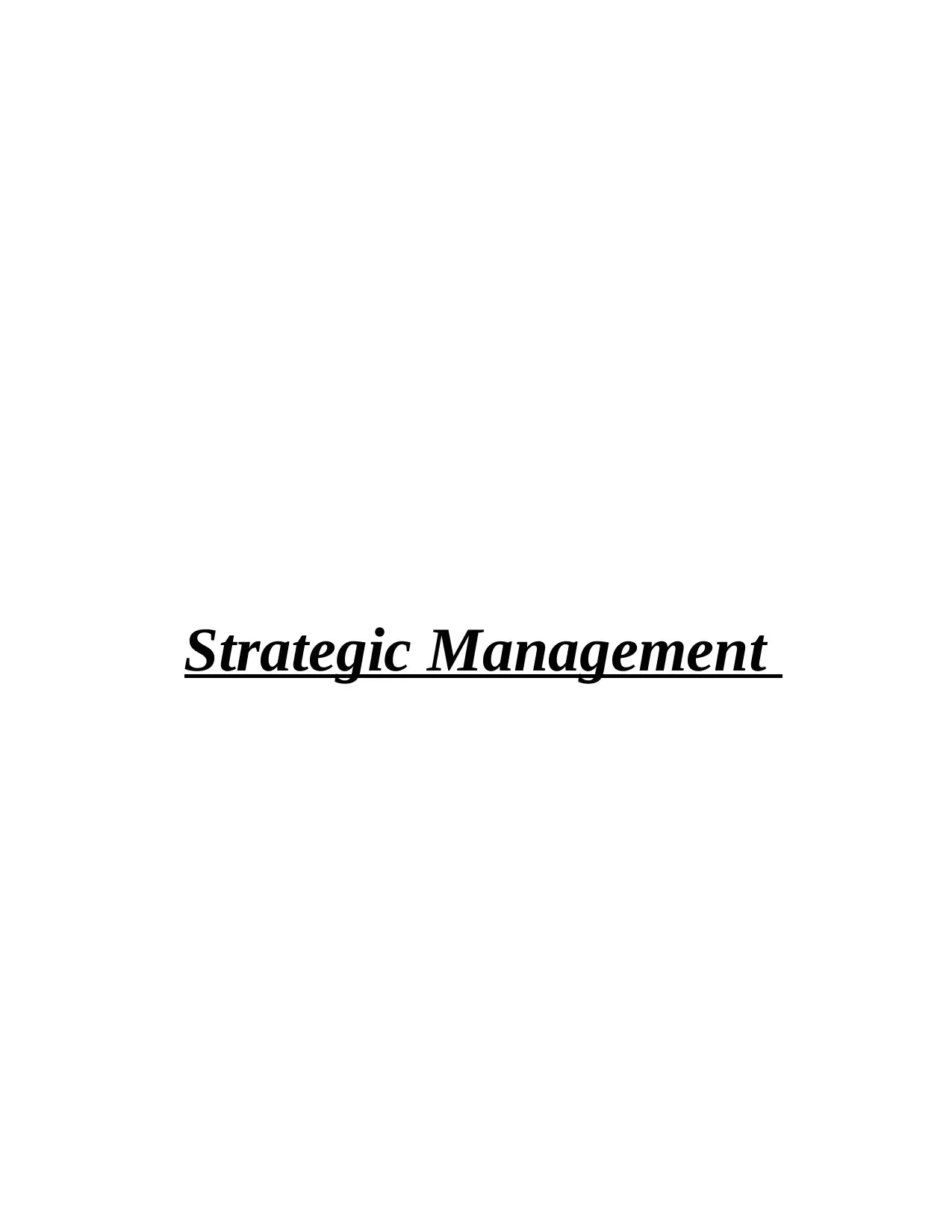
Strategic Management
Paraphrase This Document
Need a fresh take? Get an instant paraphrase of this document with our AI Paraphraser
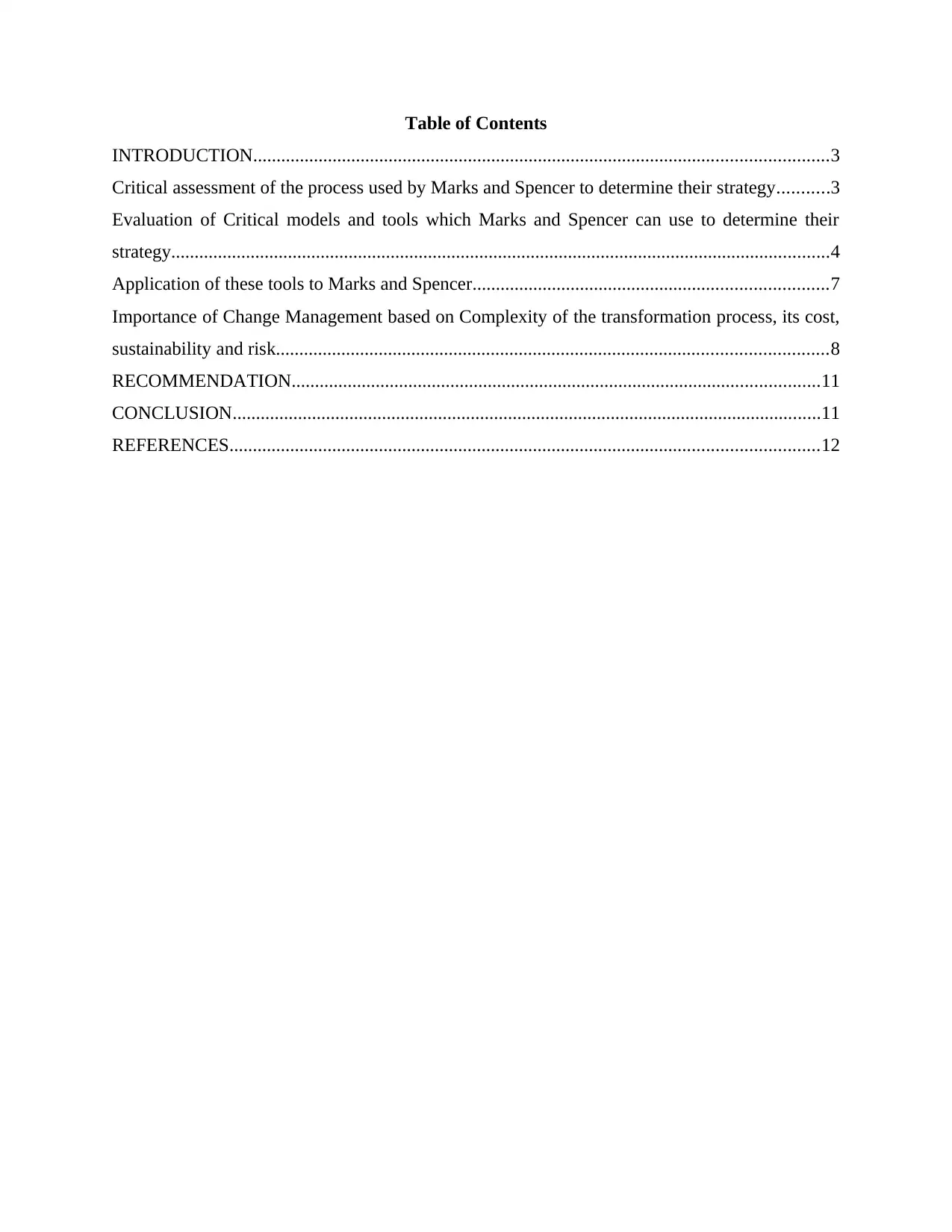
Table of Contents
INTRODUCTION...........................................................................................................................3
Critical assessment of the process used by Marks and Spencer to determine their strategy...........3
Evaluation of Critical models and tools which Marks and Spencer can use to determine their
strategy.............................................................................................................................................4
Application of these tools to Marks and Spencer............................................................................7
Importance of Change Management based on Complexity of the transformation process, its cost,
sustainability and risk......................................................................................................................8
RECOMMENDATION.................................................................................................................11
CONCLUSION..............................................................................................................................11
REFERENCES..............................................................................................................................12
INTRODUCTION...........................................................................................................................3
Critical assessment of the process used by Marks and Spencer to determine their strategy...........3
Evaluation of Critical models and tools which Marks and Spencer can use to determine their
strategy.............................................................................................................................................4
Application of these tools to Marks and Spencer............................................................................7
Importance of Change Management based on Complexity of the transformation process, its cost,
sustainability and risk......................................................................................................................8
RECOMMENDATION.................................................................................................................11
CONCLUSION..............................................................................................................................11
REFERENCES..............................................................................................................................12
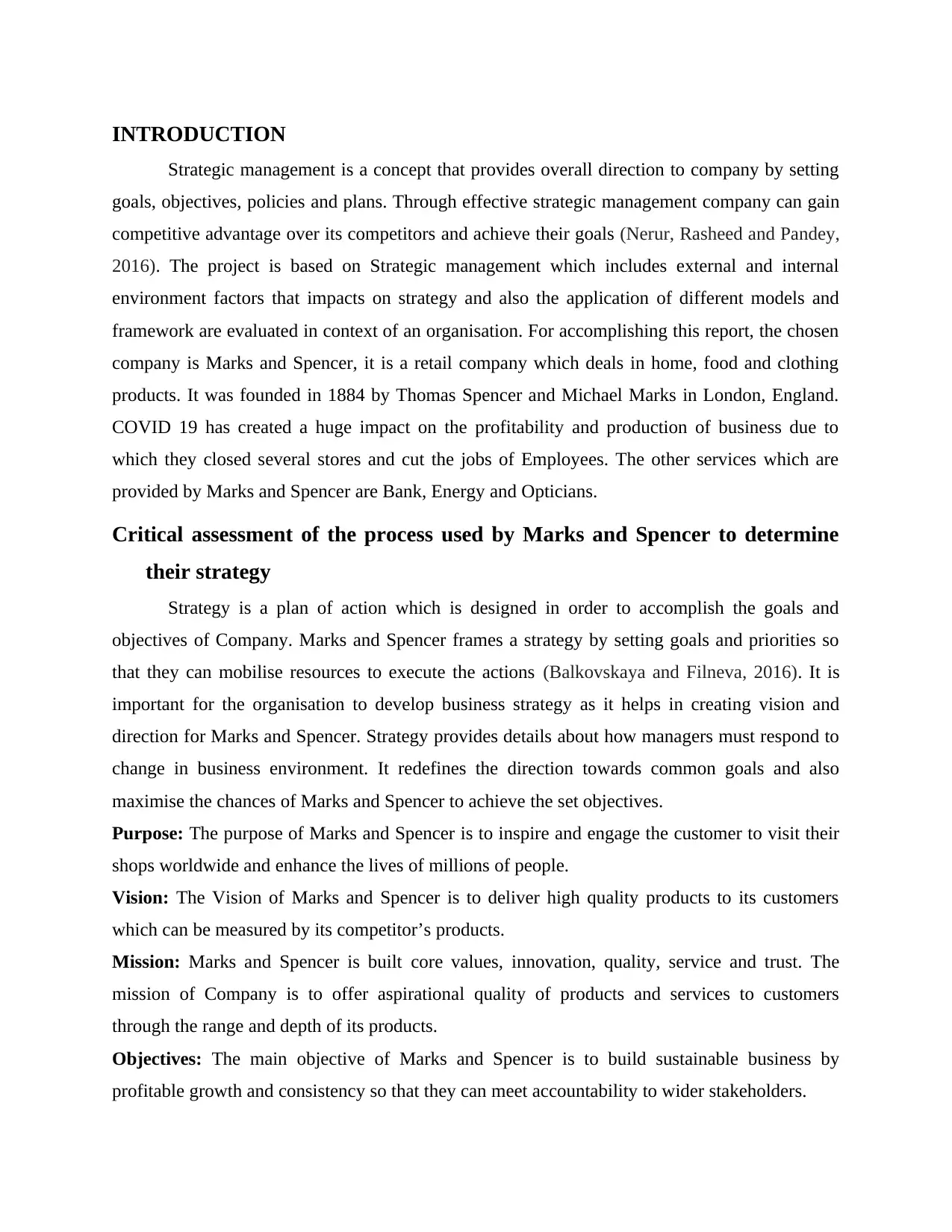
INTRODUCTION
Strategic management is a concept that provides overall direction to company by setting
goals, objectives, policies and plans. Through effective strategic management company can gain
competitive advantage over its competitors and achieve their goals (Nerur, Rasheed and Pandey,
2016). The project is based on Strategic management which includes external and internal
environment factors that impacts on strategy and also the application of different models and
framework are evaluated in context of an organisation. For accomplishing this report, the chosen
company is Marks and Spencer, it is a retail company which deals in home, food and clothing
products. It was founded in 1884 by Thomas Spencer and Michael Marks in London, England.
COVID 19 has created a huge impact on the profitability and production of business due to
which they closed several stores and cut the jobs of Employees. The other services which are
provided by Marks and Spencer are Bank, Energy and Opticians.
Critical assessment of the process used by Marks and Spencer to determine
their strategy
Strategy is a plan of action which is designed in order to accomplish the goals and
objectives of Company. Marks and Spencer frames a strategy by setting goals and priorities so
that they can mobilise resources to execute the actions (Balkovskaya and Filneva, 2016). It is
important for the organisation to develop business strategy as it helps in creating vision and
direction for Marks and Spencer. Strategy provides details about how managers must respond to
change in business environment. It redefines the direction towards common goals and also
maximise the chances of Marks and Spencer to achieve the set objectives.
Purpose: The purpose of Marks and Spencer is to inspire and engage the customer to visit their
shops worldwide and enhance the lives of millions of people.
Vision: The Vision of Marks and Spencer is to deliver high quality products to its customers
which can be measured by its competitor’s products.
Mission: Marks and Spencer is built core values, innovation, quality, service and trust. The
mission of Company is to offer aspirational quality of products and services to customers
through the range and depth of its products.
Objectives: The main objective of Marks and Spencer is to build sustainable business by
profitable growth and consistency so that they can meet accountability to wider stakeholders.
Strategic management is a concept that provides overall direction to company by setting
goals, objectives, policies and plans. Through effective strategic management company can gain
competitive advantage over its competitors and achieve their goals (Nerur, Rasheed and Pandey,
2016). The project is based on Strategic management which includes external and internal
environment factors that impacts on strategy and also the application of different models and
framework are evaluated in context of an organisation. For accomplishing this report, the chosen
company is Marks and Spencer, it is a retail company which deals in home, food and clothing
products. It was founded in 1884 by Thomas Spencer and Michael Marks in London, England.
COVID 19 has created a huge impact on the profitability and production of business due to
which they closed several stores and cut the jobs of Employees. The other services which are
provided by Marks and Spencer are Bank, Energy and Opticians.
Critical assessment of the process used by Marks and Spencer to determine
their strategy
Strategy is a plan of action which is designed in order to accomplish the goals and
objectives of Company. Marks and Spencer frames a strategy by setting goals and priorities so
that they can mobilise resources to execute the actions (Balkovskaya and Filneva, 2016). It is
important for the organisation to develop business strategy as it helps in creating vision and
direction for Marks and Spencer. Strategy provides details about how managers must respond to
change in business environment. It redefines the direction towards common goals and also
maximise the chances of Marks and Spencer to achieve the set objectives.
Purpose: The purpose of Marks and Spencer is to inspire and engage the customer to visit their
shops worldwide and enhance the lives of millions of people.
Vision: The Vision of Marks and Spencer is to deliver high quality products to its customers
which can be measured by its competitor’s products.
Mission: Marks and Spencer is built core values, innovation, quality, service and trust. The
mission of Company is to offer aspirational quality of products and services to customers
through the range and depth of its products.
Objectives: The main objective of Marks and Spencer is to build sustainable business by
profitable growth and consistency so that they can meet accountability to wider stakeholders.
⊘ This is a preview!⊘
Do you want full access?
Subscribe today to unlock all pages.

Trusted by 1+ million students worldwide
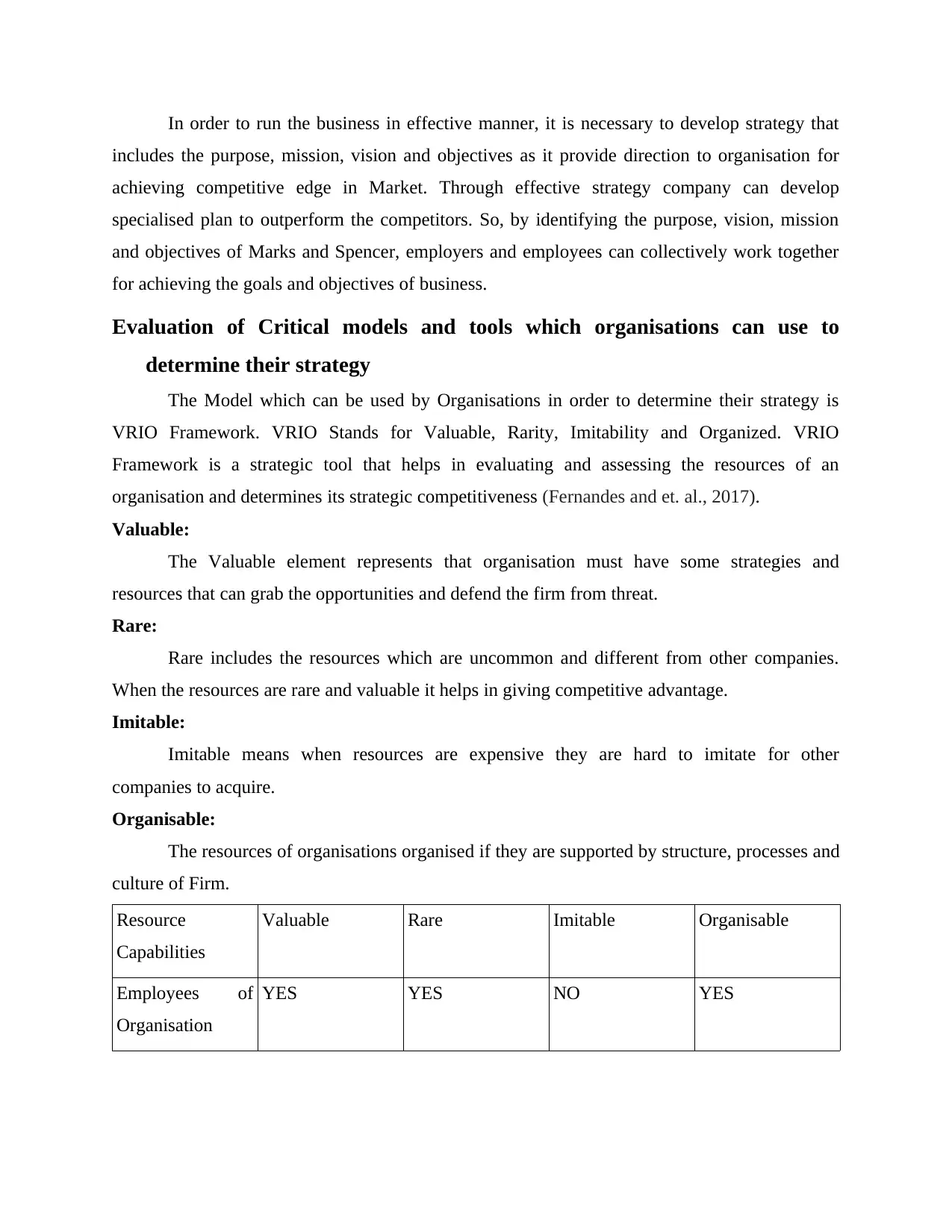
In order to run the business in effective manner, it is necessary to develop strategy that
includes the purpose, mission, vision and objectives as it provide direction to organisation for
achieving competitive edge in Market. Through effective strategy company can develop
specialised plan to outperform the competitors. So, by identifying the purpose, vision, mission
and objectives of Marks and Spencer, employers and employees can collectively work together
for achieving the goals and objectives of business.
Evaluation of Critical models and tools which organisations can use to
determine their strategy
The Model which can be used by Organisations in order to determine their strategy is
VRIO Framework. VRIO Stands for Valuable, Rarity, Imitability and Organized. VRIO
Framework is a strategic tool that helps in evaluating and assessing the resources of an
organisation and determines its strategic competitiveness (Fernandes and et. al., 2017).
Valuable:
The Valuable element represents that organisation must have some strategies and
resources that can grab the opportunities and defend the firm from threat.
Rare:
Rare includes the resources which are uncommon and different from other companies.
When the resources are rare and valuable it helps in giving competitive advantage.
Imitable:
Imitable means when resources are expensive they are hard to imitate for other
companies to acquire.
Organisable:
The resources of organisations organised if they are supported by structure, processes and
culture of Firm.
Resource
Capabilities
Valuable Rare Imitable Organisable
Employees of
Organisation
YES YES NO YES
includes the purpose, mission, vision and objectives as it provide direction to organisation for
achieving competitive edge in Market. Through effective strategy company can develop
specialised plan to outperform the competitors. So, by identifying the purpose, vision, mission
and objectives of Marks and Spencer, employers and employees can collectively work together
for achieving the goals and objectives of business.
Evaluation of Critical models and tools which organisations can use to
determine their strategy
The Model which can be used by Organisations in order to determine their strategy is
VRIO Framework. VRIO Stands for Valuable, Rarity, Imitability and Organized. VRIO
Framework is a strategic tool that helps in evaluating and assessing the resources of an
organisation and determines its strategic competitiveness (Fernandes and et. al., 2017).
Valuable:
The Valuable element represents that organisation must have some strategies and
resources that can grab the opportunities and defend the firm from threat.
Rare:
Rare includes the resources which are uncommon and different from other companies.
When the resources are rare and valuable it helps in giving competitive advantage.
Imitable:
Imitable means when resources are expensive they are hard to imitate for other
companies to acquire.
Organisable:
The resources of organisations organised if they are supported by structure, processes and
culture of Firm.
Resource
Capabilities
Valuable Rare Imitable Organisable
Employees of
Organisation
YES YES NO YES
Paraphrase This Document
Need a fresh take? Get an instant paraphrase of this document with our AI Paraphraser
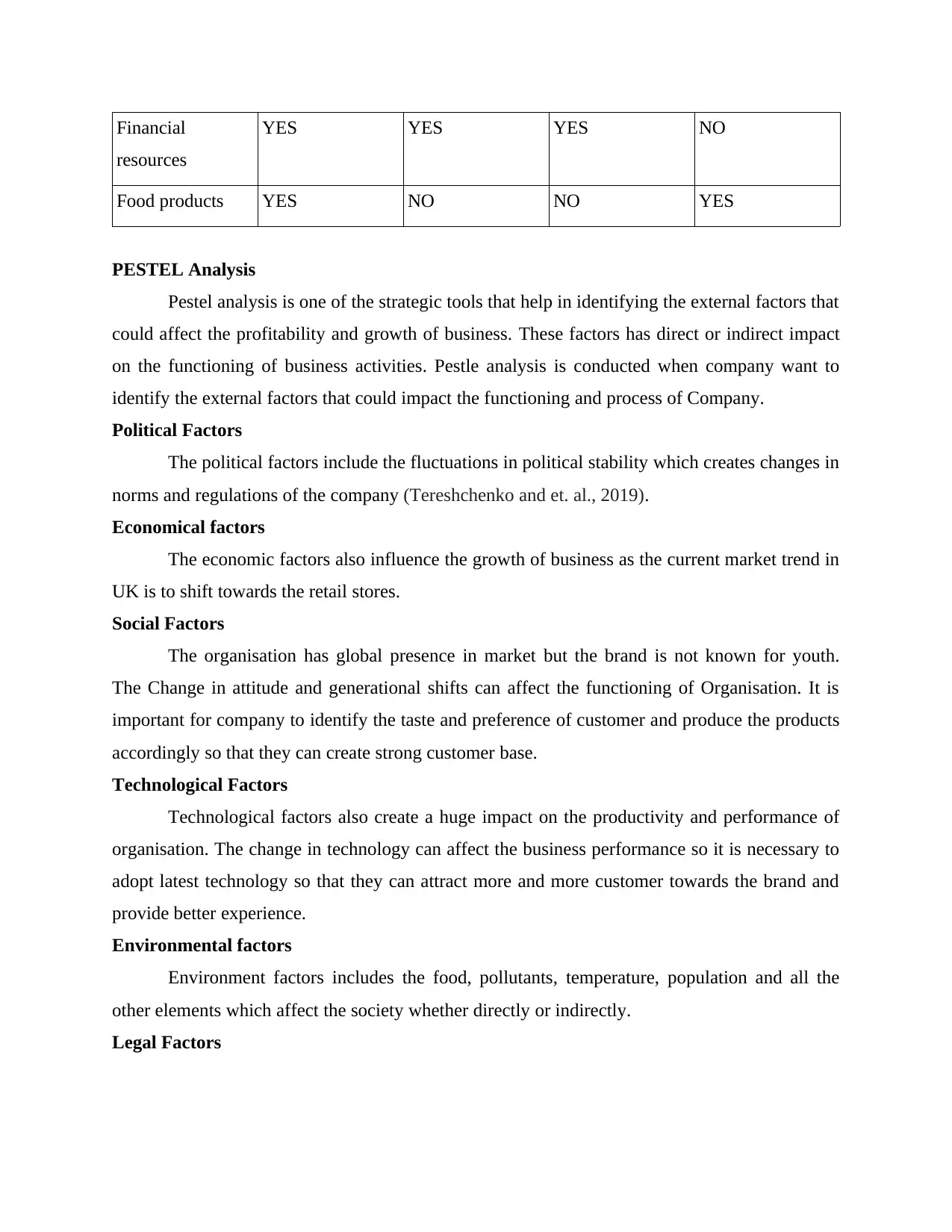
Financial
resources
YES YES YES NO
Food products YES NO NO YES
PESTEL Analysis
Pestel analysis is one of the strategic tools that help in identifying the external factors that
could affect the profitability and growth of business. These factors has direct or indirect impact
on the functioning of business activities. Pestle analysis is conducted when company want to
identify the external factors that could impact the functioning and process of Company.
Political Factors
The political factors include the fluctuations in political stability which creates changes in
norms and regulations of the company (Tereshchenko and et. al., 2019).
Economical factors
The economic factors also influence the growth of business as the current market trend in
UK is to shift towards the retail stores.
Social Factors
The organisation has global presence in market but the brand is not known for youth.
The Change in attitude and generational shifts can affect the functioning of Organisation. It is
important for company to identify the taste and preference of customer and produce the products
accordingly so that they can create strong customer base.
Technological Factors
Technological factors also create a huge impact on the productivity and performance of
organisation. The change in technology can affect the business performance so it is necessary to
adopt latest technology so that they can attract more and more customer towards the brand and
provide better experience.
Environmental factors
Environment factors includes the food, pollutants, temperature, population and all the
other elements which affect the society whether directly or indirectly.
Legal Factors
resources
YES YES YES NO
Food products YES NO NO YES
PESTEL Analysis
Pestel analysis is one of the strategic tools that help in identifying the external factors that
could affect the profitability and growth of business. These factors has direct or indirect impact
on the functioning of business activities. Pestle analysis is conducted when company want to
identify the external factors that could impact the functioning and process of Company.
Political Factors
The political factors include the fluctuations in political stability which creates changes in
norms and regulations of the company (Tereshchenko and et. al., 2019).
Economical factors
The economic factors also influence the growth of business as the current market trend in
UK is to shift towards the retail stores.
Social Factors
The organisation has global presence in market but the brand is not known for youth.
The Change in attitude and generational shifts can affect the functioning of Organisation. It is
important for company to identify the taste and preference of customer and produce the products
accordingly so that they can create strong customer base.
Technological Factors
Technological factors also create a huge impact on the productivity and performance of
organisation. The change in technology can affect the business performance so it is necessary to
adopt latest technology so that they can attract more and more customer towards the brand and
provide better experience.
Environmental factors
Environment factors includes the food, pollutants, temperature, population and all the
other elements which affect the society whether directly or indirectly.
Legal Factors
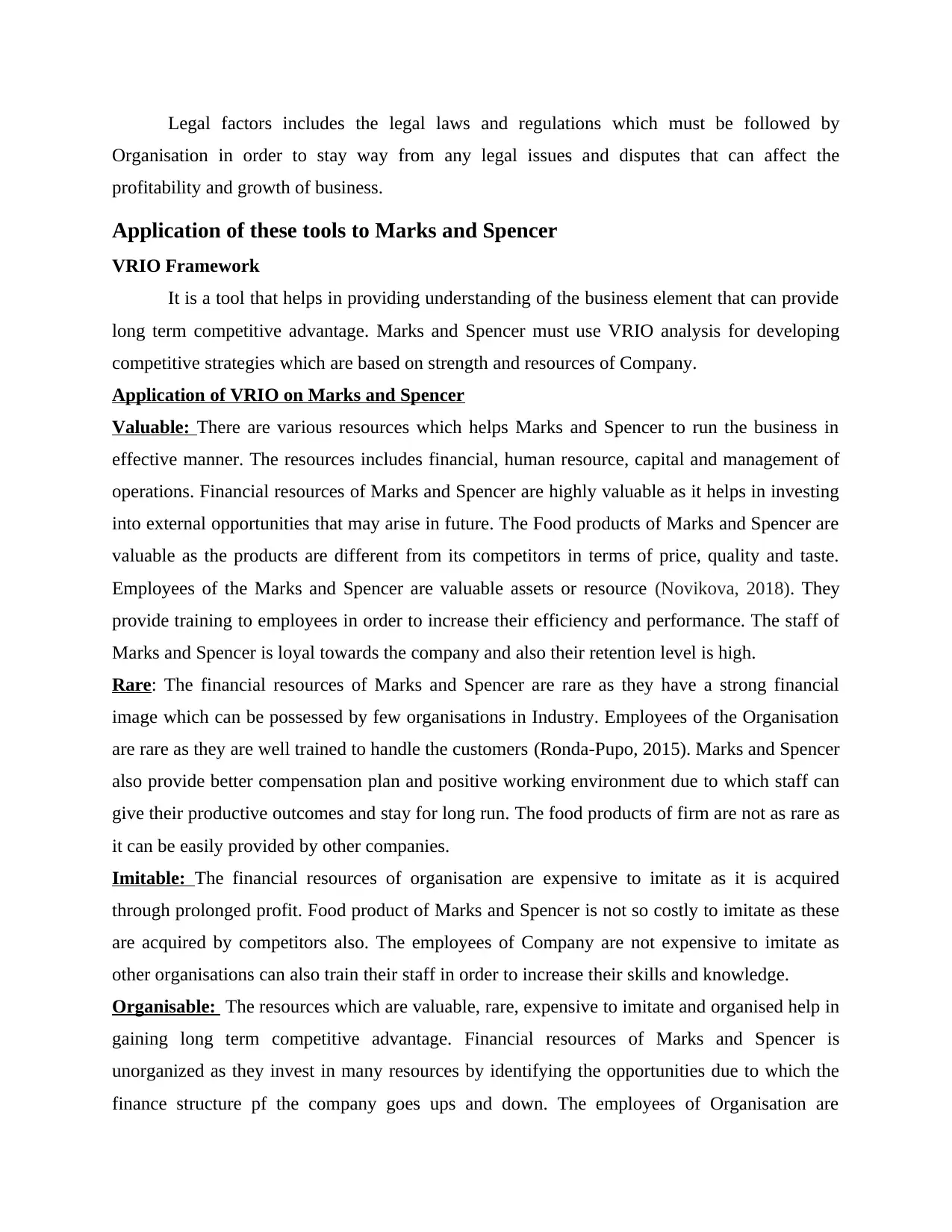
Legal factors includes the legal laws and regulations which must be followed by
Organisation in order to stay way from any legal issues and disputes that can affect the
profitability and growth of business.
Application of these tools to Marks and Spencer
VRIO Framework
It is a tool that helps in providing understanding of the business element that can provide
long term competitive advantage. Marks and Spencer must use VRIO analysis for developing
competitive strategies which are based on strength and resources of Company.
Application of VRIO on Marks and Spencer
Valuable: There are various resources which helps Marks and Spencer to run the business in
effective manner. The resources includes financial, human resource, capital and management of
operations. Financial resources of Marks and Spencer are highly valuable as it helps in investing
into external opportunities that may arise in future. The Food products of Marks and Spencer are
valuable as the products are different from its competitors in terms of price, quality and taste.
Employees of the Marks and Spencer are valuable assets or resource (Novikova, 2018). They
provide training to employees in order to increase their efficiency and performance. The staff of
Marks and Spencer is loyal towards the company and also their retention level is high.
Rare: The financial resources of Marks and Spencer are rare as they have a strong financial
image which can be possessed by few organisations in Industry. Employees of the Organisation
are rare as they are well trained to handle the customers (Ronda-Pupo, 2015). Marks and Spencer
also provide better compensation plan and positive working environment due to which staff can
give their productive outcomes and stay for long run. The food products of firm are not as rare as
it can be easily provided by other companies.
Imitable: The financial resources of organisation are expensive to imitate as it is acquired
through prolonged profit. Food product of Marks and Spencer is not so costly to imitate as these
are acquired by competitors also. The employees of Company are not expensive to imitate as
other organisations can also train their staff in order to increase their skills and knowledge.
Organisable: The resources which are valuable, rare, expensive to imitate and organised help in
gaining long term competitive advantage. Financial resources of Marks and Spencer is
unorganized as they invest in many resources by identifying the opportunities due to which the
finance structure pf the company goes ups and down. The employees of Organisation are
Organisation in order to stay way from any legal issues and disputes that can affect the
profitability and growth of business.
Application of these tools to Marks and Spencer
VRIO Framework
It is a tool that helps in providing understanding of the business element that can provide
long term competitive advantage. Marks and Spencer must use VRIO analysis for developing
competitive strategies which are based on strength and resources of Company.
Application of VRIO on Marks and Spencer
Valuable: There are various resources which helps Marks and Spencer to run the business in
effective manner. The resources includes financial, human resource, capital and management of
operations. Financial resources of Marks and Spencer are highly valuable as it helps in investing
into external opportunities that may arise in future. The Food products of Marks and Spencer are
valuable as the products are different from its competitors in terms of price, quality and taste.
Employees of the Marks and Spencer are valuable assets or resource (Novikova, 2018). They
provide training to employees in order to increase their efficiency and performance. The staff of
Marks and Spencer is loyal towards the company and also their retention level is high.
Rare: The financial resources of Marks and Spencer are rare as they have a strong financial
image which can be possessed by few organisations in Industry. Employees of the Organisation
are rare as they are well trained to handle the customers (Ronda-Pupo, 2015). Marks and Spencer
also provide better compensation plan and positive working environment due to which staff can
give their productive outcomes and stay for long run. The food products of firm are not as rare as
it can be easily provided by other companies.
Imitable: The financial resources of organisation are expensive to imitate as it is acquired
through prolonged profit. Food product of Marks and Spencer is not so costly to imitate as these
are acquired by competitors also. The employees of Company are not expensive to imitate as
other organisations can also train their staff in order to increase their skills and knowledge.
Organisable: The resources which are valuable, rare, expensive to imitate and organised help in
gaining long term competitive advantage. Financial resources of Marks and Spencer is
unorganized as they invest in many resources by identifying the opportunities due to which the
finance structure pf the company goes ups and down. The employees of Organisation are
⊘ This is a preview!⊘
Do you want full access?
Subscribe today to unlock all pages.

Trusted by 1+ million students worldwide
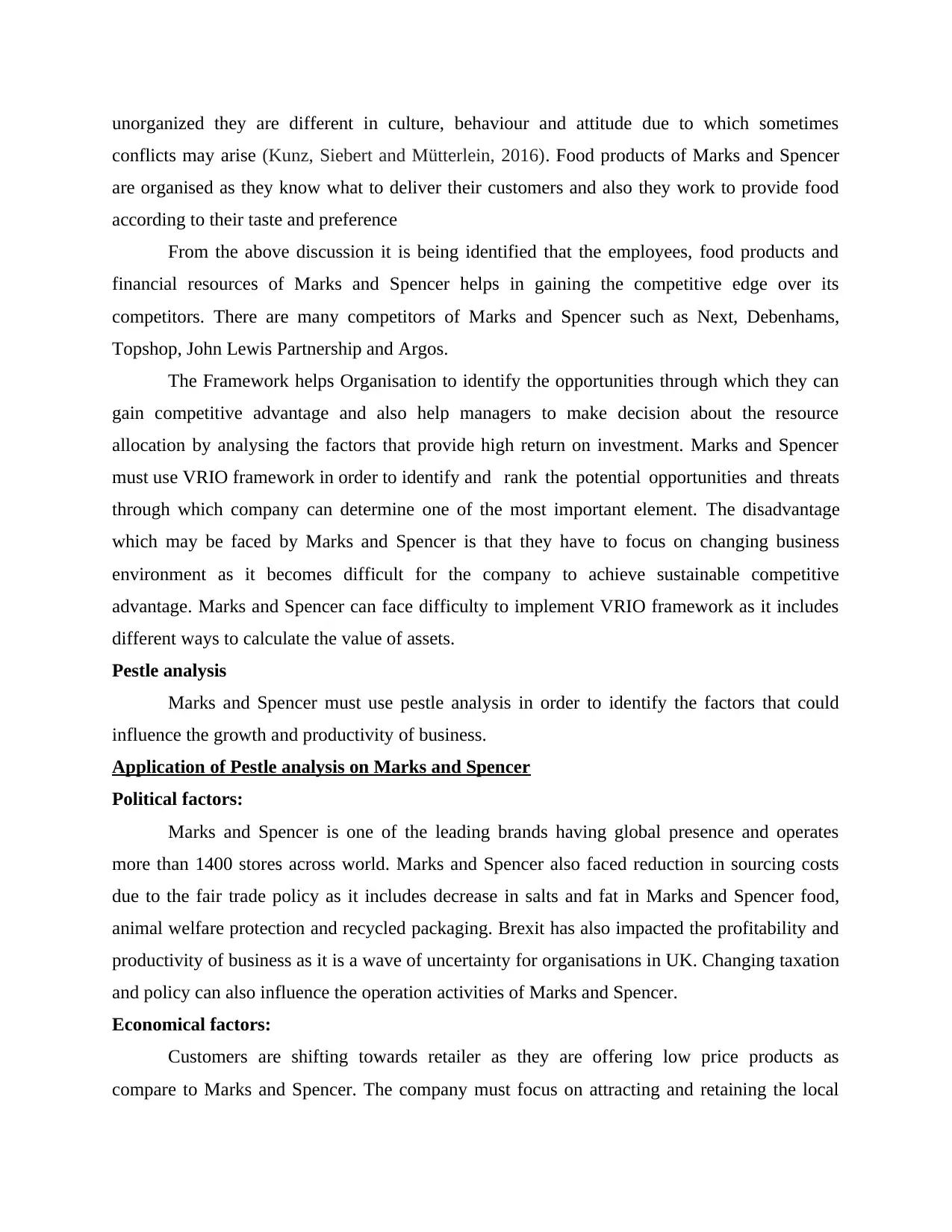
unorganized they are different in culture, behaviour and attitude due to which sometimes
conflicts may arise (Kunz, Siebert and Mütterlein, 2016). Food products of Marks and Spencer
are organised as they know what to deliver their customers and also they work to provide food
according to their taste and preference
From the above discussion it is being identified that the employees, food products and
financial resources of Marks and Spencer helps in gaining the competitive edge over its
competitors. There are many competitors of Marks and Spencer such as Next, Debenhams,
Topshop, John Lewis Partnership and Argos.
The Framework helps Organisation to identify the opportunities through which they can
gain competitive advantage and also help managers to make decision about the resource
allocation by analysing the factors that provide high return on investment. Marks and Spencer
must use VRIO framework in order to identify and rank the potential opportunities and threats
through which company can determine one of the most important element. The disadvantage
which may be faced by Marks and Spencer is that they have to focus on changing business
environment as it becomes difficult for the company to achieve sustainable competitive
advantage. Marks and Spencer can face difficulty to implement VRIO framework as it includes
different ways to calculate the value of assets.
Pestle analysis
Marks and Spencer must use pestle analysis in order to identify the factors that could
influence the growth and productivity of business.
Application of Pestle analysis on Marks and Spencer
Political factors:
Marks and Spencer is one of the leading brands having global presence and operates
more than 1400 stores across world. Marks and Spencer also faced reduction in sourcing costs
due to the fair trade policy as it includes decrease in salts and fat in Marks and Spencer food,
animal welfare protection and recycled packaging. Brexit has also impacted the profitability and
productivity of business as it is a wave of uncertainty for organisations in UK. Changing taxation
and policy can also influence the operation activities of Marks and Spencer.
Economical factors:
Customers are shifting towards retailer as they are offering low price products as
compare to Marks and Spencer. The company must focus on attracting and retaining the local
conflicts may arise (Kunz, Siebert and Mütterlein, 2016). Food products of Marks and Spencer
are organised as they know what to deliver their customers and also they work to provide food
according to their taste and preference
From the above discussion it is being identified that the employees, food products and
financial resources of Marks and Spencer helps in gaining the competitive edge over its
competitors. There are many competitors of Marks and Spencer such as Next, Debenhams,
Topshop, John Lewis Partnership and Argos.
The Framework helps Organisation to identify the opportunities through which they can
gain competitive advantage and also help managers to make decision about the resource
allocation by analysing the factors that provide high return on investment. Marks and Spencer
must use VRIO framework in order to identify and rank the potential opportunities and threats
through which company can determine one of the most important element. The disadvantage
which may be faced by Marks and Spencer is that they have to focus on changing business
environment as it becomes difficult for the company to achieve sustainable competitive
advantage. Marks and Spencer can face difficulty to implement VRIO framework as it includes
different ways to calculate the value of assets.
Pestle analysis
Marks and Spencer must use pestle analysis in order to identify the factors that could
influence the growth and productivity of business.
Application of Pestle analysis on Marks and Spencer
Political factors:
Marks and Spencer is one of the leading brands having global presence and operates
more than 1400 stores across world. Marks and Spencer also faced reduction in sourcing costs
due to the fair trade policy as it includes decrease in salts and fat in Marks and Spencer food,
animal welfare protection and recycled packaging. Brexit has also impacted the profitability and
productivity of business as it is a wave of uncertainty for organisations in UK. Changing taxation
and policy can also influence the operation activities of Marks and Spencer.
Economical factors:
Customers are shifting towards retailer as they are offering low price products as
compare to Marks and Spencer. The company must focus on attracting and retaining the local
Paraphrase This Document
Need a fresh take? Get an instant paraphrase of this document with our AI Paraphraser
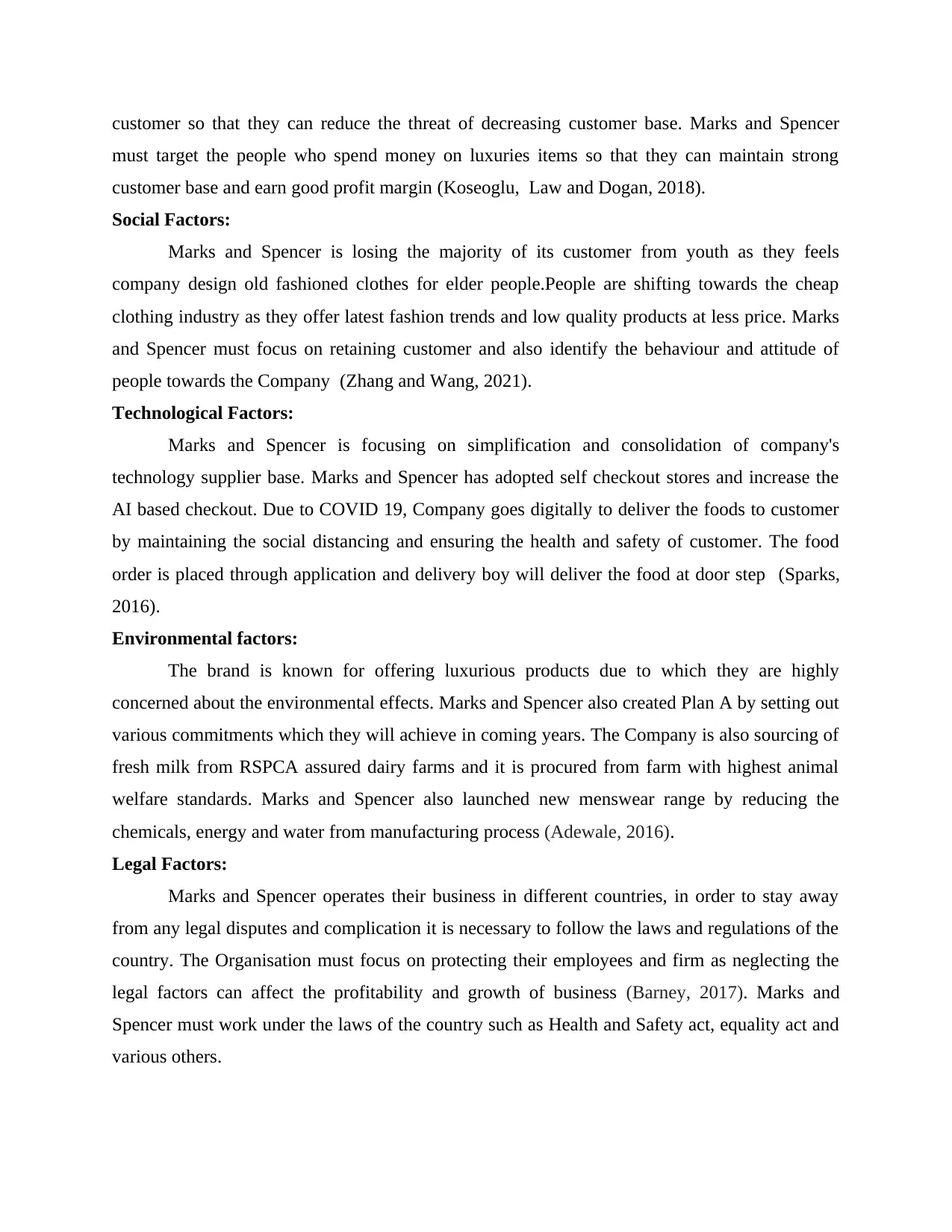
customer so that they can reduce the threat of decreasing customer base. Marks and Spencer
must target the people who spend money on luxuries items so that they can maintain strong
customer base and earn good profit margin (Koseoglu, Law and Dogan, 2018).
Social Factors:
Marks and Spencer is losing the majority of its customer from youth as they feels
company design old fashioned clothes for elder people.People are shifting towards the cheap
clothing industry as they offer latest fashion trends and low quality products at less price. Marks
and Spencer must focus on retaining customer and also identify the behaviour and attitude of
people towards the Company (Zhang and Wang, 2021).
Technological Factors:
Marks and Spencer is focusing on simplification and consolidation of company's
technology supplier base. Marks and Spencer has adopted self checkout stores and increase the
AI based checkout. Due to COVID 19, Company goes digitally to deliver the foods to customer
by maintaining the social distancing and ensuring the health and safety of customer. The food
order is placed through application and delivery boy will deliver the food at door step (Sparks,
2016).
Environmental factors:
The brand is known for offering luxurious products due to which they are highly
concerned about the environmental effects. Marks and Spencer also created Plan A by setting out
various commitments which they will achieve in coming years. The Company is also sourcing of
fresh milk from RSPCA assured dairy farms and it is procured from farm with highest animal
welfare standards. Marks and Spencer also launched new menswear range by reducing the
chemicals, energy and water from manufacturing process (Adewale, 2016).
Legal Factors:
Marks and Spencer operates their business in different countries, in order to stay away
from any legal disputes and complication it is necessary to follow the laws and regulations of the
country. The Organisation must focus on protecting their employees and firm as neglecting the
legal factors can affect the profitability and growth of business (Barney, 2017). Marks and
Spencer must work under the laws of the country such as Health and Safety act, equality act and
various others.
must target the people who spend money on luxuries items so that they can maintain strong
customer base and earn good profit margin (Koseoglu, Law and Dogan, 2018).
Social Factors:
Marks and Spencer is losing the majority of its customer from youth as they feels
company design old fashioned clothes for elder people.People are shifting towards the cheap
clothing industry as they offer latest fashion trends and low quality products at less price. Marks
and Spencer must focus on retaining customer and also identify the behaviour and attitude of
people towards the Company (Zhang and Wang, 2021).
Technological Factors:
Marks and Spencer is focusing on simplification and consolidation of company's
technology supplier base. Marks and Spencer has adopted self checkout stores and increase the
AI based checkout. Due to COVID 19, Company goes digitally to deliver the foods to customer
by maintaining the social distancing and ensuring the health and safety of customer. The food
order is placed through application and delivery boy will deliver the food at door step (Sparks,
2016).
Environmental factors:
The brand is known for offering luxurious products due to which they are highly
concerned about the environmental effects. Marks and Spencer also created Plan A by setting out
various commitments which they will achieve in coming years. The Company is also sourcing of
fresh milk from RSPCA assured dairy farms and it is procured from farm with highest animal
welfare standards. Marks and Spencer also launched new menswear range by reducing the
chemicals, energy and water from manufacturing process (Adewale, 2016).
Legal Factors:
Marks and Spencer operates their business in different countries, in order to stay away
from any legal disputes and complication it is necessary to follow the laws and regulations of the
country. The Organisation must focus on protecting their employees and firm as neglecting the
legal factors can affect the profitability and growth of business (Barney, 2017). Marks and
Spencer must work under the laws of the country such as Health and Safety act, equality act and
various others.
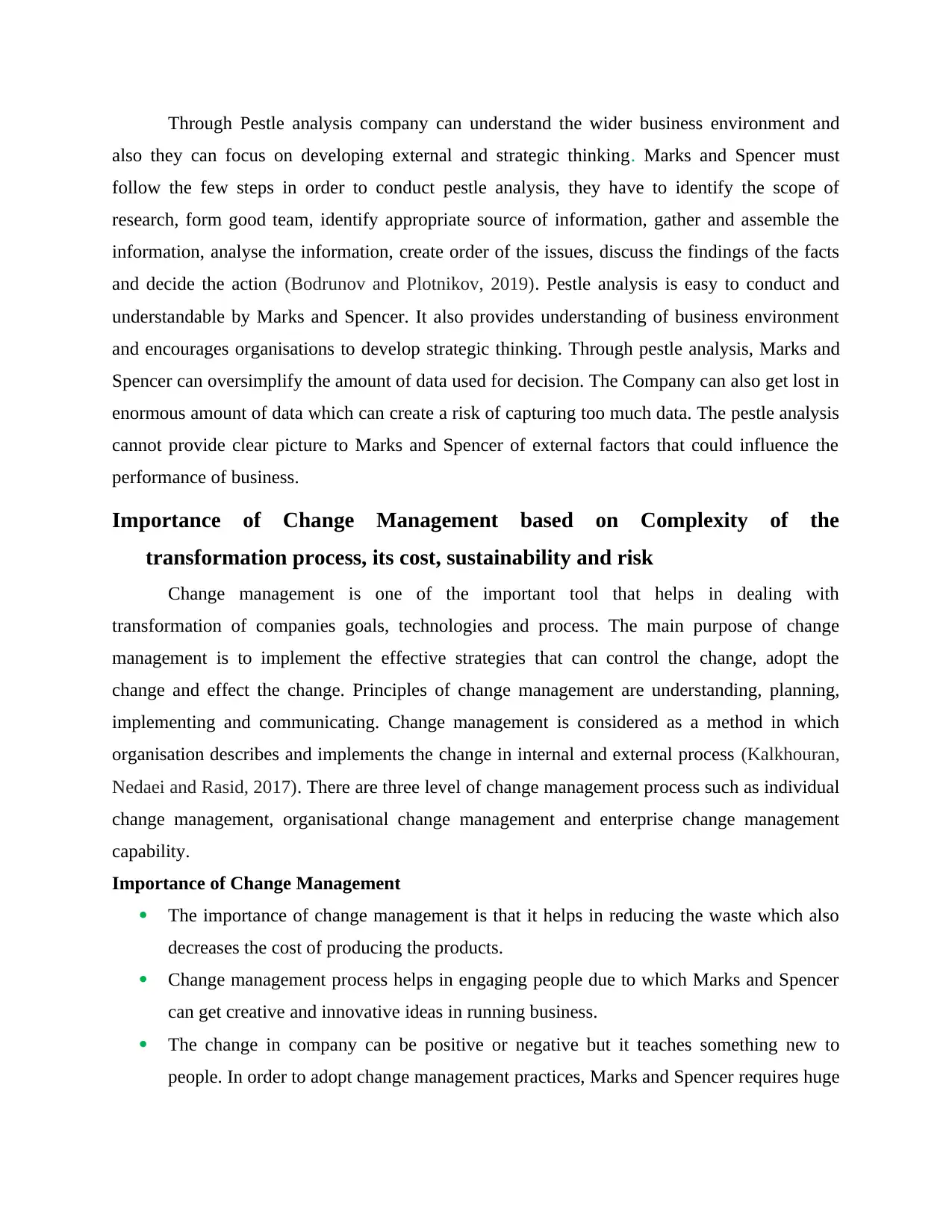
Through Pestle analysis company can understand the wider business environment and
also they can focus on developing external and strategic thinking. Marks and Spencer must
follow the few steps in order to conduct pestle analysis, they have to identify the scope of
research, form good team, identify appropriate source of information, gather and assemble the
information, analyse the information, create order of the issues, discuss the findings of the facts
and decide the action (Bodrunov and Plotnikov, 2019). Pestle analysis is easy to conduct and
understandable by Marks and Spencer. It also provides understanding of business environment
and encourages organisations to develop strategic thinking. Through pestle analysis, Marks and
Spencer can oversimplify the amount of data used for decision. The Company can also get lost in
enormous amount of data which can create a risk of capturing too much data. The pestle analysis
cannot provide clear picture to Marks and Spencer of external factors that could influence the
performance of business.
Importance of Change Management based on Complexity of the
transformation process, its cost, sustainability and risk
Change management is one of the important tool that helps in dealing with
transformation of companies goals, technologies and process. The main purpose of change
management is to implement the effective strategies that can control the change, adopt the
change and effect the change. Principles of change management are understanding, planning,
implementing and communicating. Change management is considered as a method in which
organisation describes and implements the change in internal and external process (Kalkhouran,
Nedaei and Rasid, 2017). There are three level of change management process such as individual
change management, organisational change management and enterprise change management
capability.
Importance of Change Management
The importance of change management is that it helps in reducing the waste which also
decreases the cost of producing the products.
Change management process helps in engaging people due to which Marks and Spencer
can get creative and innovative ideas in running business.
The change in company can be positive or negative but it teaches something new to
people. In order to adopt change management practices, Marks and Spencer requires huge
also they can focus on developing external and strategic thinking. Marks and Spencer must
follow the few steps in order to conduct pestle analysis, they have to identify the scope of
research, form good team, identify appropriate source of information, gather and assemble the
information, analyse the information, create order of the issues, discuss the findings of the facts
and decide the action (Bodrunov and Plotnikov, 2019). Pestle analysis is easy to conduct and
understandable by Marks and Spencer. It also provides understanding of business environment
and encourages organisations to develop strategic thinking. Through pestle analysis, Marks and
Spencer can oversimplify the amount of data used for decision. The Company can also get lost in
enormous amount of data which can create a risk of capturing too much data. The pestle analysis
cannot provide clear picture to Marks and Spencer of external factors that could influence the
performance of business.
Importance of Change Management based on Complexity of the
transformation process, its cost, sustainability and risk
Change management is one of the important tool that helps in dealing with
transformation of companies goals, technologies and process. The main purpose of change
management is to implement the effective strategies that can control the change, adopt the
change and effect the change. Principles of change management are understanding, planning,
implementing and communicating. Change management is considered as a method in which
organisation describes and implements the change in internal and external process (Kalkhouran,
Nedaei and Rasid, 2017). There are three level of change management process such as individual
change management, organisational change management and enterprise change management
capability.
Importance of Change Management
The importance of change management is that it helps in reducing the waste which also
decreases the cost of producing the products.
Change management process helps in engaging people due to which Marks and Spencer
can get creative and innovative ideas in running business.
The change in company can be positive or negative but it teaches something new to
people. In order to adopt change management practices, Marks and Spencer requires huge
⊘ This is a preview!⊘
Do you want full access?
Subscribe today to unlock all pages.

Trusted by 1+ million students worldwide
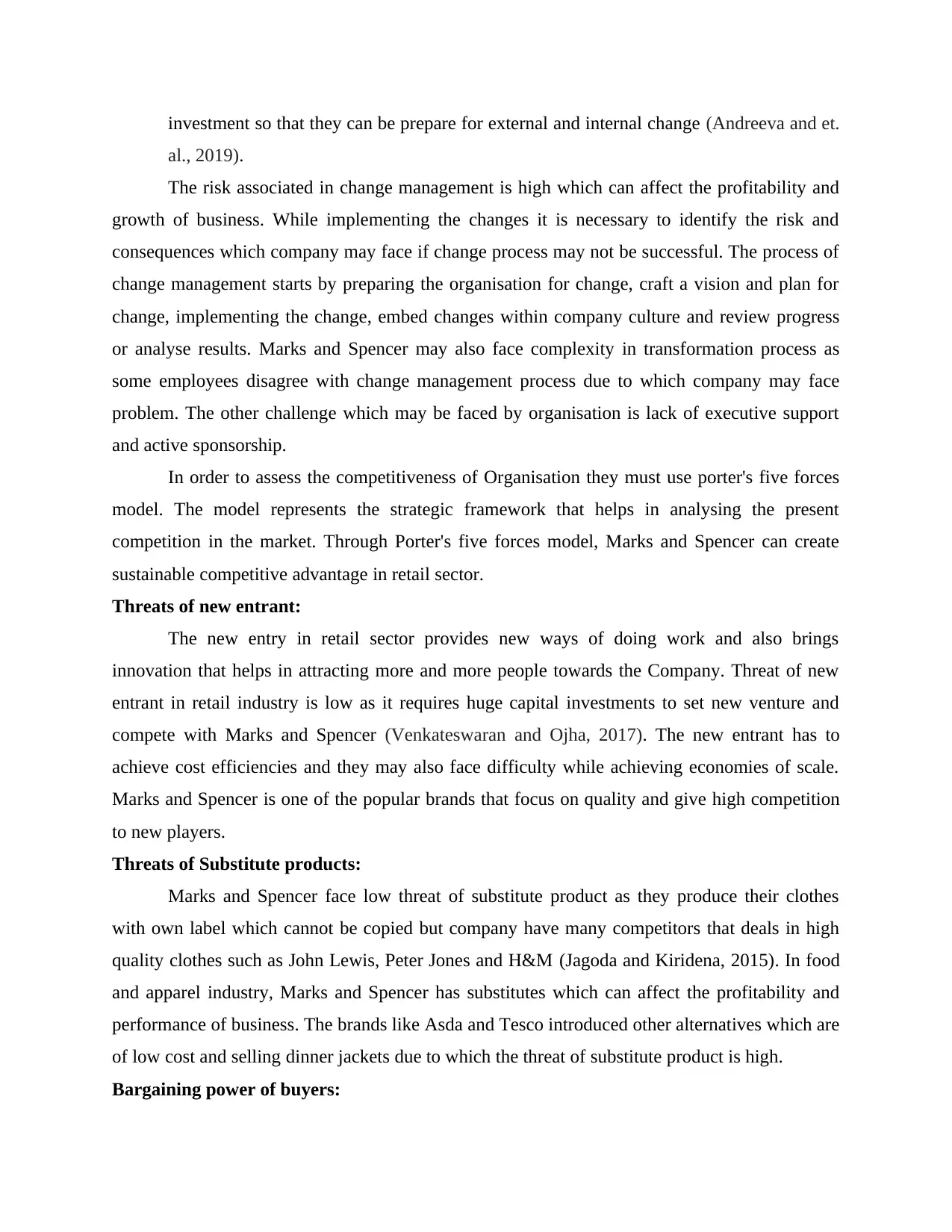
investment so that they can be prepare for external and internal change (Andreeva and et.
al., 2019).
The risk associated in change management is high which can affect the profitability and
growth of business. While implementing the changes it is necessary to identify the risk and
consequences which company may face if change process may not be successful. The process of
change management starts by preparing the organisation for change, craft a vision and plan for
change, implementing the change, embed changes within company culture and review progress
or analyse results. Marks and Spencer may also face complexity in transformation process as
some employees disagree with change management process due to which company may face
problem. The other challenge which may be faced by organisation is lack of executive support
and active sponsorship.
In order to assess the competitiveness of Organisation they must use porter's five forces
model. The model represents the strategic framework that helps in analysing the present
competition in the market. Through Porter's five forces model, Marks and Spencer can create
sustainable competitive advantage in retail sector.
Threats of new entrant:
The new entry in retail sector provides new ways of doing work and also brings
innovation that helps in attracting more and more people towards the Company. Threat of new
entrant in retail industry is low as it requires huge capital investments to set new venture and
compete with Marks and Spencer (Venkateswaran and Ojha, 2017). The new entrant has to
achieve cost efficiencies and they may also face difficulty while achieving economies of scale.
Marks and Spencer is one of the popular brands that focus on quality and give high competition
to new players.
Threats of Substitute products:
Marks and Spencer face low threat of substitute product as they produce their clothes
with own label which cannot be copied but company have many competitors that deals in high
quality clothes such as John Lewis, Peter Jones and H&M (Jagoda and Kiridena, 2015). In food
and apparel industry, Marks and Spencer has substitutes which can affect the profitability and
performance of business. The brands like Asda and Tesco introduced other alternatives which are
of low cost and selling dinner jackets due to which the threat of substitute product is high.
Bargaining power of buyers:
al., 2019).
The risk associated in change management is high which can affect the profitability and
growth of business. While implementing the changes it is necessary to identify the risk and
consequences which company may face if change process may not be successful. The process of
change management starts by preparing the organisation for change, craft a vision and plan for
change, implementing the change, embed changes within company culture and review progress
or analyse results. Marks and Spencer may also face complexity in transformation process as
some employees disagree with change management process due to which company may face
problem. The other challenge which may be faced by organisation is lack of executive support
and active sponsorship.
In order to assess the competitiveness of Organisation they must use porter's five forces
model. The model represents the strategic framework that helps in analysing the present
competition in the market. Through Porter's five forces model, Marks and Spencer can create
sustainable competitive advantage in retail sector.
Threats of new entrant:
The new entry in retail sector provides new ways of doing work and also brings
innovation that helps in attracting more and more people towards the Company. Threat of new
entrant in retail industry is low as it requires huge capital investments to set new venture and
compete with Marks and Spencer (Venkateswaran and Ojha, 2017). The new entrant has to
achieve cost efficiencies and they may also face difficulty while achieving economies of scale.
Marks and Spencer is one of the popular brands that focus on quality and give high competition
to new players.
Threats of Substitute products:
Marks and Spencer face low threat of substitute product as they produce their clothes
with own label which cannot be copied but company have many competitors that deals in high
quality clothes such as John Lewis, Peter Jones and H&M (Jagoda and Kiridena, 2015). In food
and apparel industry, Marks and Spencer has substitutes which can affect the profitability and
performance of business. The brands like Asda and Tesco introduced other alternatives which are
of low cost and selling dinner jackets due to which the threat of substitute product is high.
Bargaining power of buyers:
Paraphrase This Document
Need a fresh take? Get an instant paraphrase of this document with our AI Paraphraser
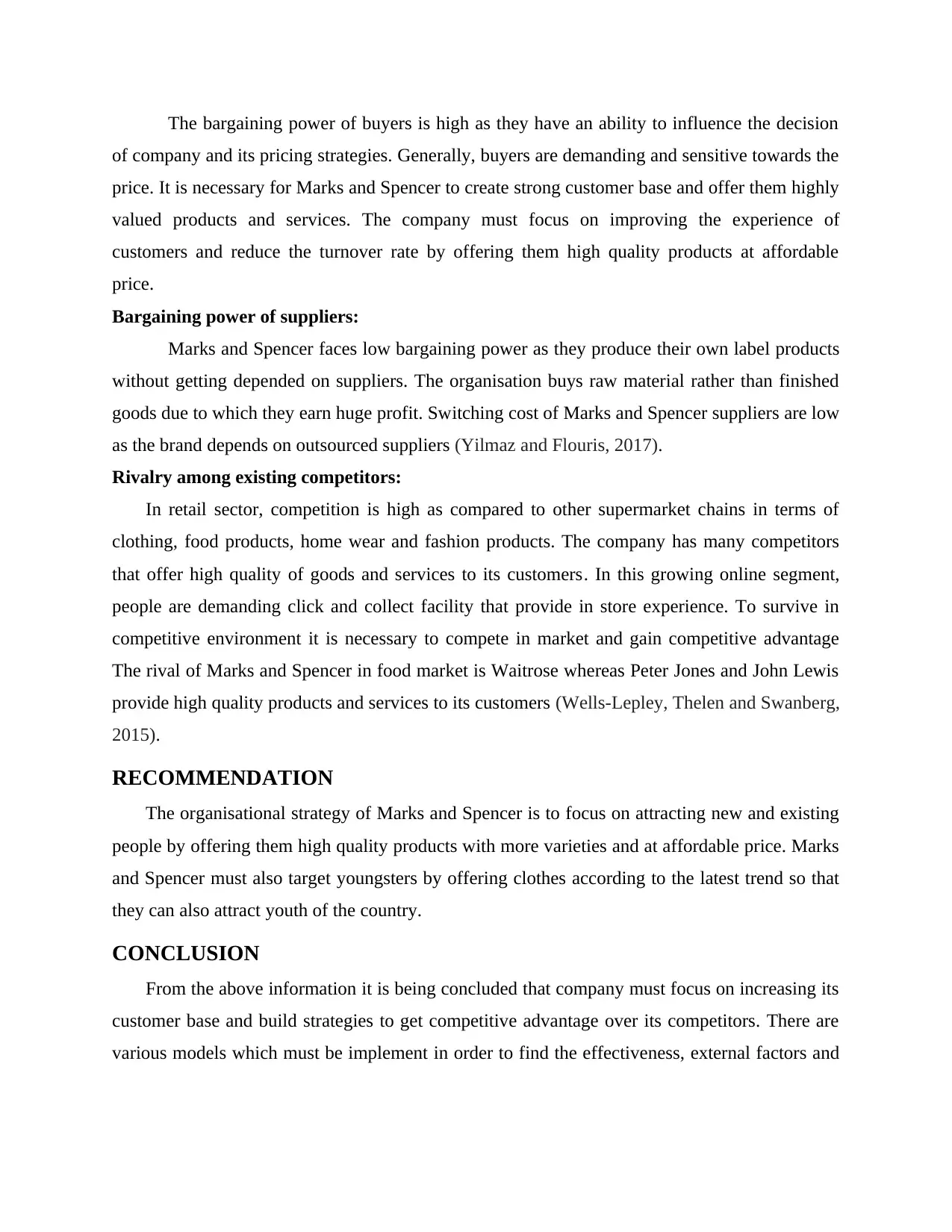
The bargaining power of buyers is high as they have an ability to influence the decision
of company and its pricing strategies. Generally, buyers are demanding and sensitive towards the
price. It is necessary for Marks and Spencer to create strong customer base and offer them highly
valued products and services. The company must focus on improving the experience of
customers and reduce the turnover rate by offering them high quality products at affordable
price.
Bargaining power of suppliers:
Marks and Spencer faces low bargaining power as they produce their own label products
without getting depended on suppliers. The organisation buys raw material rather than finished
goods due to which they earn huge profit. Switching cost of Marks and Spencer suppliers are low
as the brand depends on outsourced suppliers (Yilmaz and Flouris, 2017).
Rivalry among existing competitors:
In retail sector, competition is high as compared to other supermarket chains in terms of
clothing, food products, home wear and fashion products. The company has many competitors
that offer high quality of goods and services to its customers. In this growing online segment,
people are demanding click and collect facility that provide in store experience. To survive in
competitive environment it is necessary to compete in market and gain competitive advantage
The rival of Marks and Spencer in food market is Waitrose whereas Peter Jones and John Lewis
provide high quality products and services to its customers (Wells-Lepley, Thelen and Swanberg,
2015).
RECOMMENDATION
The organisational strategy of Marks and Spencer is to focus on attracting new and existing
people by offering them high quality products with more varieties and at affordable price. Marks
and Spencer must also target youngsters by offering clothes according to the latest trend so that
they can also attract youth of the country.
CONCLUSION
From the above information it is being concluded that company must focus on increasing its
customer base and build strategies to get competitive advantage over its competitors. There are
various models which must be implement in order to find the effectiveness, external factors and
of company and its pricing strategies. Generally, buyers are demanding and sensitive towards the
price. It is necessary for Marks and Spencer to create strong customer base and offer them highly
valued products and services. The company must focus on improving the experience of
customers and reduce the turnover rate by offering them high quality products at affordable
price.
Bargaining power of suppliers:
Marks and Spencer faces low bargaining power as they produce their own label products
without getting depended on suppliers. The organisation buys raw material rather than finished
goods due to which they earn huge profit. Switching cost of Marks and Spencer suppliers are low
as the brand depends on outsourced suppliers (Yilmaz and Flouris, 2017).
Rivalry among existing competitors:
In retail sector, competition is high as compared to other supermarket chains in terms of
clothing, food products, home wear and fashion products. The company has many competitors
that offer high quality of goods and services to its customers. In this growing online segment,
people are demanding click and collect facility that provide in store experience. To survive in
competitive environment it is necessary to compete in market and gain competitive advantage
The rival of Marks and Spencer in food market is Waitrose whereas Peter Jones and John Lewis
provide high quality products and services to its customers (Wells-Lepley, Thelen and Swanberg,
2015).
RECOMMENDATION
The organisational strategy of Marks and Spencer is to focus on attracting new and existing
people by offering them high quality products with more varieties and at affordable price. Marks
and Spencer must also target youngsters by offering clothes according to the latest trend so that
they can also attract youth of the country.
CONCLUSION
From the above information it is being concluded that company must focus on increasing its
customer base and build strategies to get competitive advantage over its competitors. There are
various models which must be implement in order to find the effectiveness, external factors and

competitive advantage. Through these models and tools, organisation can know about its strength
and weakness and also they can know about their level of competitiveness in market.
and weakness and also they can know about their level of competitiveness in market.
⊘ This is a preview!⊘
Do you want full access?
Subscribe today to unlock all pages.

Trusted by 1+ million students worldwide
1 out of 14
Related Documents
Your All-in-One AI-Powered Toolkit for Academic Success.
+13062052269
info@desklib.com
Available 24*7 on WhatsApp / Email
![[object Object]](/_next/static/media/star-bottom.7253800d.svg)
Unlock your academic potential
Copyright © 2020–2025 A2Z Services. All Rights Reserved. Developed and managed by ZUCOL.




